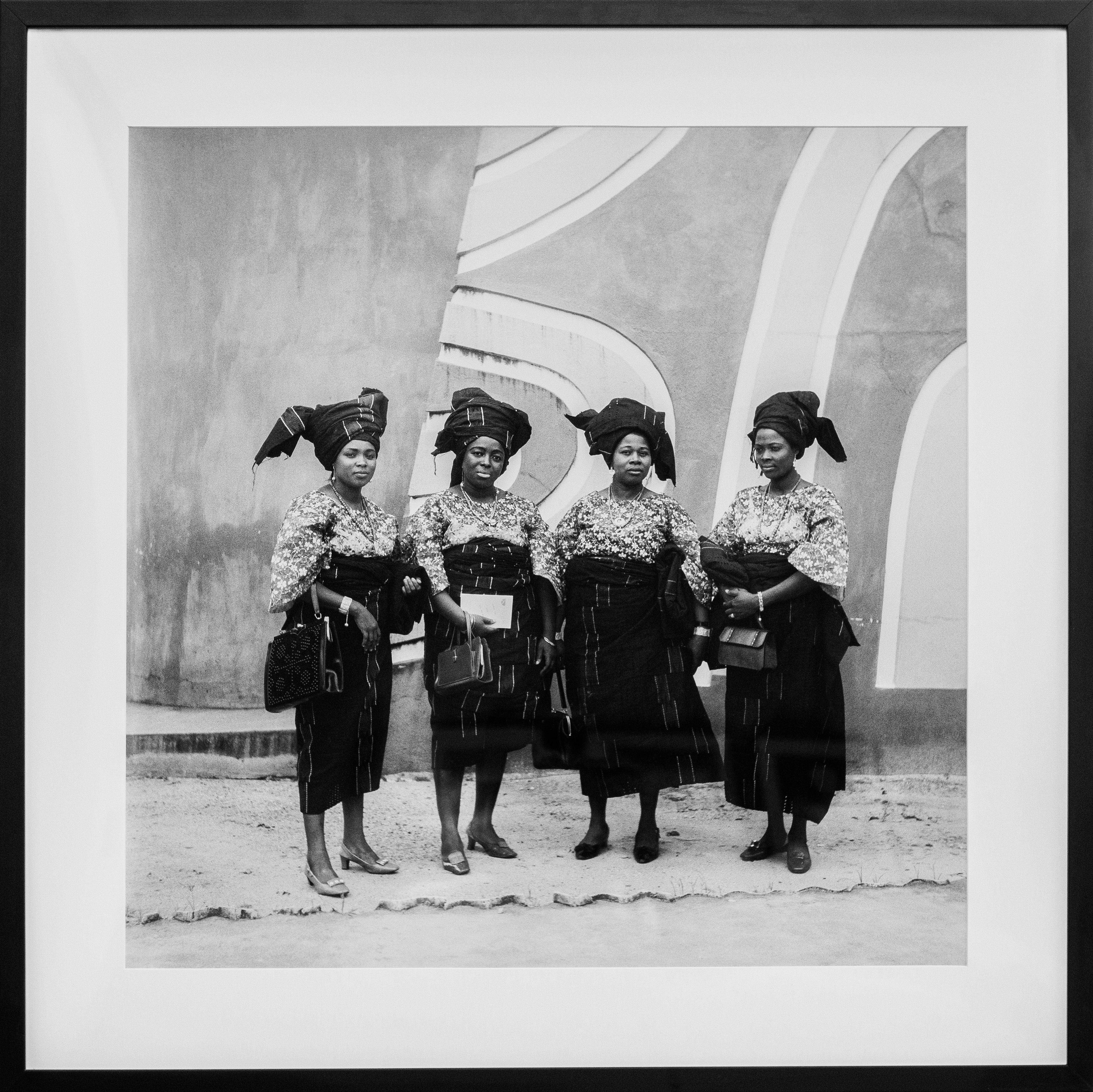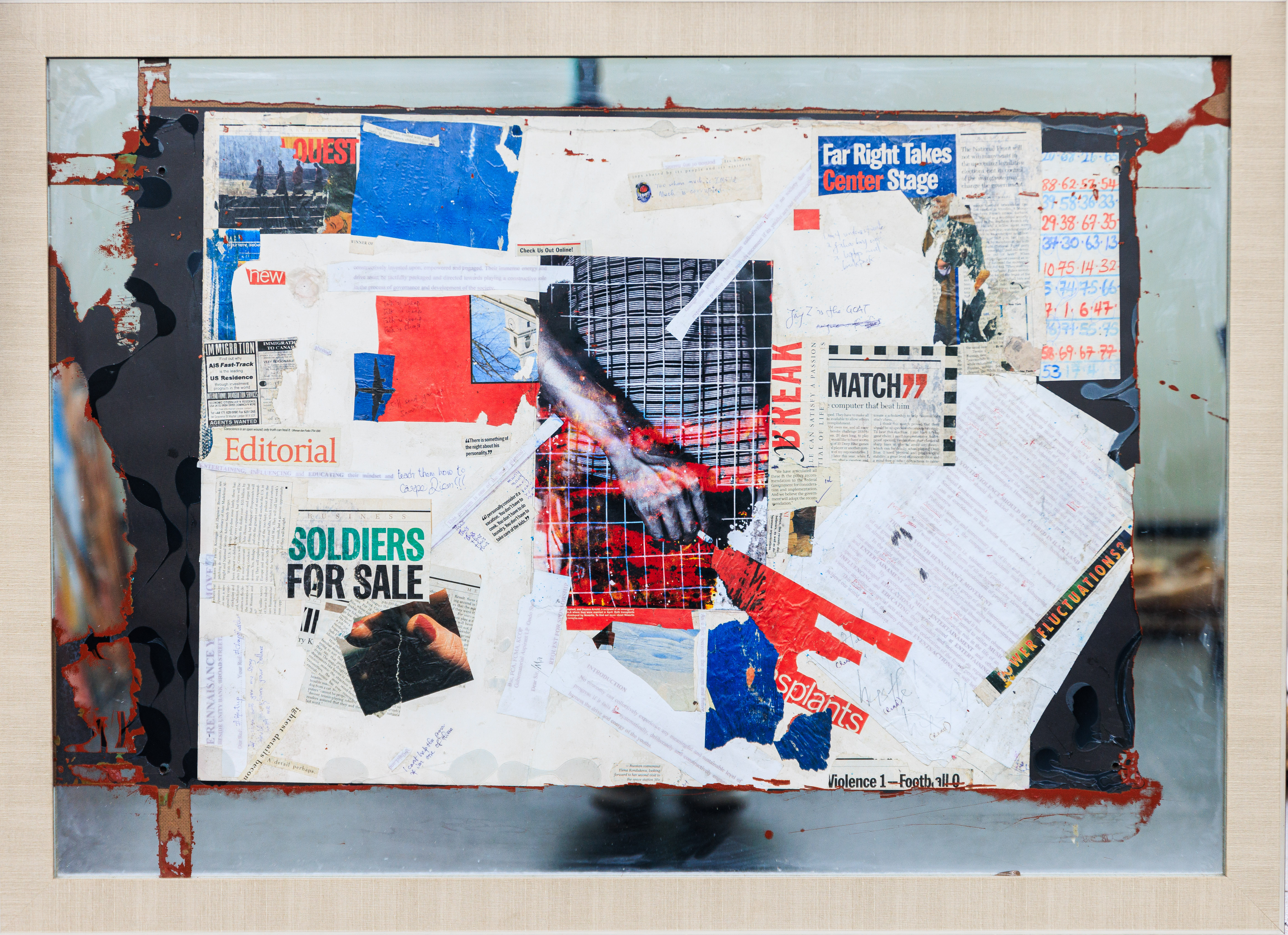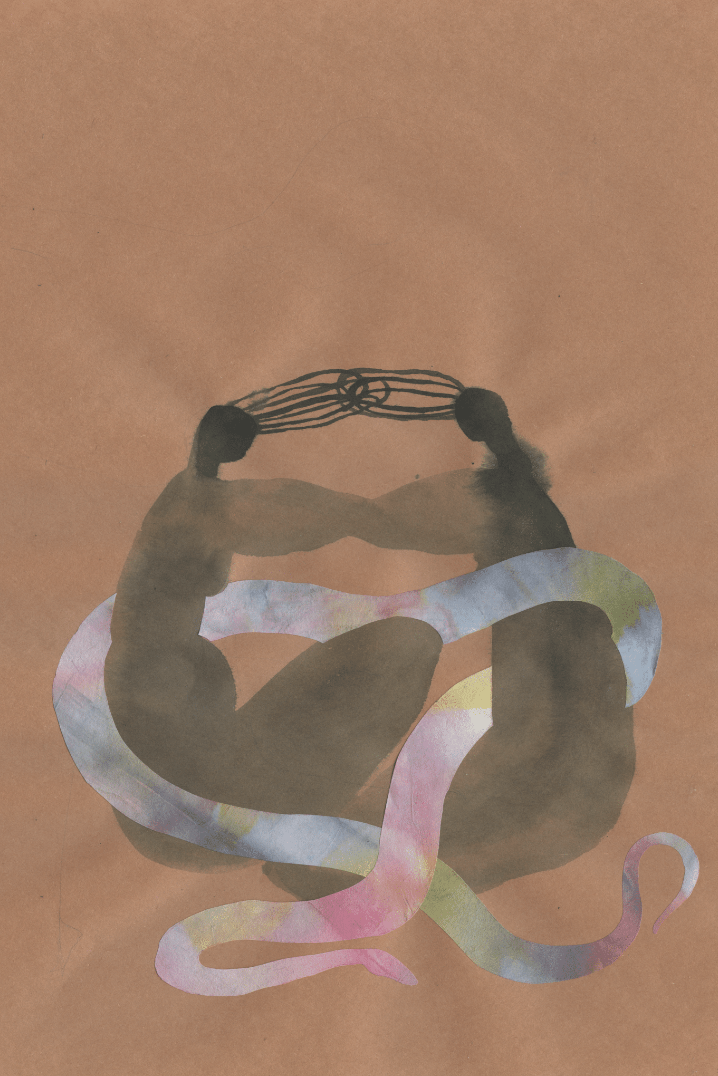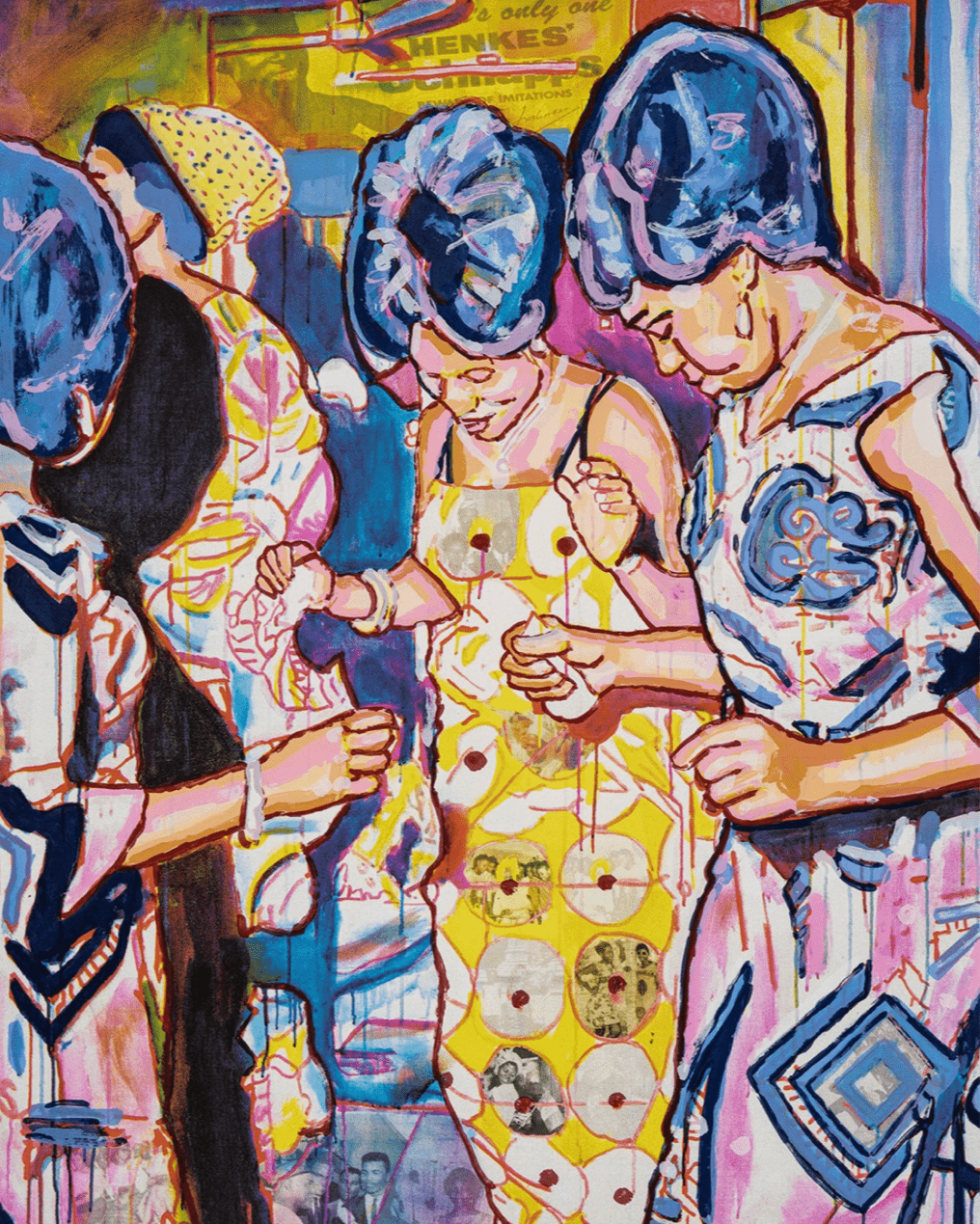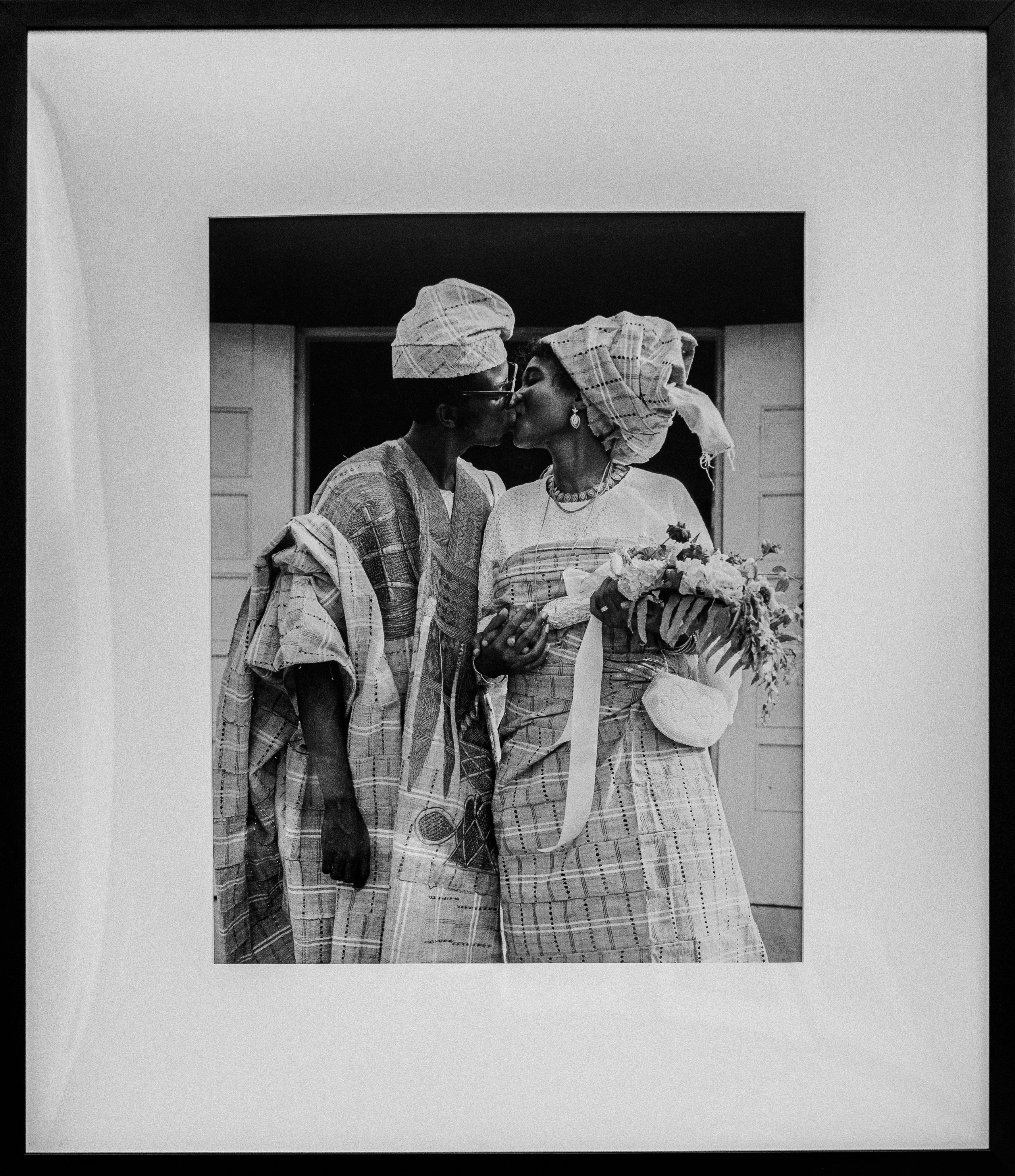Image Impressions, an exhibition of photographs, paintings, and collages curated by Faridah Folawiyo, aims to trace Nigeria’s visual history and embrace the multitudinous aspects of the country’s reality.
The works hang in a small round house with a reed ceiling. The dome-shaped coffee-brown ceiling, an inner ring of regularly spaced white walls, a green four-walled block at their centre, and the low louvered windows with rolled-up slats overlooking the trees outside give the house an air of quaint sophistication. The house sits, close to the entrance gate, in the compound of the Vaughan-Richards House, in Ikoyi, Lagos.
The photographs of Nigerian photographer, J.D. ‘Okhai Ojeikere, hanging on one face of the green block, are the first things one sees on entering the round house. Their positioning marks them out as the centrepieces of Image Impressions, an exhibition of photographs, paintings, and collages by twelve artists curated by Faridah Folawiyo. Ojeikere’s photographs, four fairly small pieces in glass frames, are portraits of people posing in pairs, totalling six women and two men.
The men, wearing traditional clothes and sandals, are holding hands. One has a small smile while the other holds his face in serious focus. The women are dressed in independence-era style clothes, all of them smiling. The good mood and optimism of the period are ostensible. Almost all the photos were taken shortly after or just before Nigeria’s independence in 1960. Ojeikere’s photos make clear that these are not simply models, but people who actually know each other and are happy to be photographed together.
OJEIKERE AND THE ARTISTS AFTER HIM
Ojeikere did much of his important work after Nigeria’s independence. A new wave of optimism and national pride was sweeping across the country and the continent. People were taken by a fervour for African ways and a need to define, as markedly as possible, a new African identity—an identity that would announce modern Africa to the world. This identity, reflected in fashion, architecture, music, literature, and art, shaped up to be an amalgam of everything they had been as Africans as well as all they currently were and aspired to be. Ojeikere chose documentary photography to make a record of his people at this time. Among his extensive body of work are portraits (the only ones included in this exhibition), photographs of colonial architecture, and an impressive collection of hairstyles worn by Nigerian women.
From when Ojeikere got his Brownie D camera in 1950 to when he began working at the Ministry of Information in Ibadan in 1957 to his work with a division of Western Nigeria Broadcasting Council in 1961 and Nigerian Arts Council in 1967, his work kept in rhythm with the ebb and flow of Nigerian society. The other artists in the show, all of whom are Nigerian, take over from him. Like him, they document Nigerian people and the cultural cum social climate of the country.
Shining through the exhibition is the flair with which they do this. Nowhere is this more pointedly seen than in Lakin Ogunbanwo’s photographs in the show, luminous portraits with blazing colours and flamboyant, richly patterned fabrics. Born in Lagos in 1987, Ogunbanwo studied law in Nigeria and the UK before becoming a fashion photographer in 2012. Since then, he has photographed international models and notable figures like spoken word poet, Wana Udobang and novelist, Chimamanda Ngozi Adichie. His work is full of lustre and self-possession and ensouled by an unassailable interiority.
In …what would bragging look like (2022), a man wearing a glossy agbada and a flattened cylindrical cap, both elaborately patterned with flowers, has his back turned to us. His head is trained forwards, but with a gaze slightly averted to the side. His hands, almost entirely swallowed up in the folds of the fabric, are clutching behind him a bouquet of flowers. It is a photograph of irresistible visual appeal with the texture of something palpable yet not quite graspable.
Working toward a similar end of fashioning a new African identity, Ogunbanwo puts a spin on the traditional styles and formal techniques of Ojeikere and other pioneers of modern African photography like Seydou Keïta and Mama Casset. Through the generations, their work is poised, carefully arranged, and ennobling. These larger points got down, the other things are a variation on the theme, affording ample opportunities for aesthetic plenitude.
A RADICAL SHIFT
For everything one can say about Nigerian art, both laudable and unflattering, one thing not in question is that there’s a great deal of artistic talent across the country. With the passing of the years since independence, this abundance of talent has become more apparent, with more artists gaining greater visibility and recognition for their work. In the work of this new generation of artists, one notices a shift, an irreverent boldness and freedom not quite found in the work of artists just after independence.
A radical post-colonial mindset and a keen focus on personhood and identity are the forces animating their work. Their creations reveal a sense of freedom and a potent mind, a mind capable of forging new expressions, beholden first to itself and its own unique perception of things. Joy Labinjo, Chigozie Obi, Olayemi Fagbohungbe, and Frida Orupabo are among the artists doing this kind of work.
Chinaza Agbor, one of the exhibiting artists in the show, paints with a similar radicality. Born in 1998 in Dallas, Texas, to Nigerian parents, she obtained an MA in painting from the Royal College of Art, London in 2021. Her style is sensual and transfixing, characterized by surreal atmospheres peopled by umber figures with skins of neon glow. She blends realism and fantasy to create pieces set in entrancing psychological spaces.
Almost everything she paints is sad, no matter how ostensibly happy or satisfied some of her figures may appear. It is sadness that seems to flow beneath the paint like an undercurrent. An Unrequited Fantasy (2021-2023), her only work in the exhibition, shows lovers, a man and a woman, in sad embrace. They are standing in a dreamlike place as if to underscore the point that everything is an illusion. Across the top right of the painting are the words, Greetings from. It’s a painting about the sadness of parting, and the sometimes illusory promise of love.
An exhibition, like a work of art, if it is well conceived and executed, refers to itself as well as to things larger and more varied than itself. It is an entry point for reflections and remembrances of various kinds, bearing witness to and offering some kind of handle on reality. Image Impressions proves to be a microcosm of some of the multitudinous aspects of Nigerian reality.
AN ESSENTIAL SIDE NOTE
Logo Oluwamuyiwa’s Far Right Takes Centre Stage (Fragility of Hope Series, 2019), a patchwork of newspaper clippings, magazine cut-outs, pictures, slogans and aphorisms, hanging in a corner room, is a microcosm of sorts. Scrawled or pasted all over it are words: Far Right Takes Centre Stage, SOLDIERS FOR SALE, Jay Z is the GOAT, To Whom Much is IMF’d Much is corrupted, Don’t underestimate a yahoo boy with a laptop and a backpack, Change and progress in all human collectivities. There is no society that can experience positive change and advancement if its youth are not strategically…, MATCH, Violence 1 – Football 0. There is a clear note of lament, for an ailing polity, for the helplessness in the face of a corrupt government and for a country’s broken promise. This is by far the most political piece in the exhibition. The allusions—and this is perhaps why Oluwamimuyiwa chose the collage form for it—are far-ranging, almost scattershot.
The medley seems to keep growing. And in some way, it invites us to add to it as well—our laments and our musings, our anger and our frustrations. Nigerians remember the country’s beleaguered past and its floundering present. Everyone remembers the coups and counter coups, the looting and overseas bank accounts, the failed schemes and graft. Everyone remembers the Nigerian Civil War. Everyone remembers #EndSARS and the bald-faced violence of government. Everyone remembers the rigged elections and fraudulent electoral processes. Everyone remembers the hard economy. There is no easy salve for the lament of the Nigerian people, and Oluwamuyiwa’s piece doesn’t promise one. It simply is a place to post a growing discontent, for whatever that is worth. In an exhibition not so much about politics as about culture and the softer aspects of human intimacy, Oluwamuyiwa’s work is an essential side note.
THE MANY FACES OF IMAGE IMPRESSIONS
On the day of the opening reception, under a canopy of trees and hanging lights, a female choir dressed in striped dashikis sang songs through the evening—Brymo, Aṣa, Ebenezer Obey—delivering them fairly well but in a gospel-inflected cadence. A fine counterpoint to the art, the music lowered all mid-groove into the swing of the decades.
The rest of the show resembles whorls, with gently connecting arms and tendrils. In Chioma Ebinama’s Ihe 11 (2019), two women sit in a ring; their hands are linked; their hair, extending like branches, are also linked, and a heart-shaped whorl goes around them. In Helena Foster’s Study—The Scent of Disillusion (2023), a man and a woman sit under the leaves of a spare tree, talking to each other. The man has a flower in his hand. He is not offering it to the woman, nor does he seem about to. Their postures are matter of fact, the man listening, and the woman perhaps explaining to him why a relationship cannot work between them. In Foster’s second piece, I See You In My Eyes (2023), however, the affection between the couple and their mutual agreement to be in the relationship are not in question.
Only three paintings, and the gesture again is made as if to embrace the many dynamics of love. It becomes clear that this is something at the heart of Folawiyo’s curation: keep the scale miniature, but the allusions wide-ranging. Speaking in an interview over Zoom, she explained that she was interested in how studio photography, especially from Nigeria’s independence era, has shaped the aesthetics of visual artists working today. For her, it was important to find ‘painters who looked at painting almost in the same way that photographers looked at photography,’ capturing a specific moment in their paintings and zooming in on that to tell their own stories and that of their time. Across media, whether photography or painting or collage, the idea was to work outwards, from the intimate and specific to the more universal and world-embracing.
Esiri Erheriene-Essi’s And All of My Friends Were There (2022) is a screenprint of women dancing. They’re wearing colourful floral dresses, their hair glossy and beautifully coiffed. It seems to be a nightclub from back in the day, with the words There’s only one HENKES’ SCHNAPPS, slightly obstructed by a fan, corroborating that impression.
Ekene Emeka-Maduka’s, Super Sweet Gist: Vanilla FanIce; Fan Milk LTD Ghana (1960), a vertical diptych, is also a painting of happy times. The panel above and the one beneath show, in the faces of two girls, the wide-eyed longing and joy of licking FanIce. Many Nigerians have fond childhood memories of buying that ice cream.
Nostalgia gives way to the more animistic paintings of Richard Ayodeji Ikhide and the collage work of Adebunmi Gbadebo. Ikhide incorporates in his paintings the myths and symbols of the past with those of a potential future, striving to create a visual language that is alive with the touchstones of his culture. Gbadebo’s Uprooted (2017) is a map of Africa taped onto a board with paper, thread, silk skin, and synthetic braids. The work, which evokes the wooly hair of Africans when full and uncombed, is an invitation to consider the embattled history of the continent. Slavery, colonialism, and displacement are the visual echoes coming from it.
No two artists in the show could be more different in style and concerns than Remi Ajani and Mobolaji Ogunrosoye. Ajani’s Looking Glass (2023) is an office setting, suit and tie, clean clothes and formal manners. Ogunrosoye’s Untitled Self Portrait 01-06 (in progress) and Untitled Miniature 01-03 (in progress) (2021-2023) are self-portraits of the photographer. They are small photos. Some of them show her face, a few show her bust and back, while others show her, discreetly, in the nude. In all of them she is happy, an unapologetic record of her own joy.
The Vaughan-Richards House adds to the experience of the works. Blending Western architectural styles and traditional Nigerian influences, the house is a work of art itself redolent of Nigeria’s history and mood through the years. Built by British-Nigerian architect Alan Vaughan-Richards in the 1960s, the house saw Ikoyi transform from a fishing village to a hub of expensive real estate. From the vantage of its small segment of Lagos Island, having lived through the aesthetic and social transformation of Nigeria, nowhere better could have been home to the exhibition.
We come, as if full circle, to Ojeikere again. WDL 1313 (1965). Easily the most iconic and riveting photograph in the room, it shows a kissing couple dressed in aṣọ-òkè. They hold themselves close to each other with clasped hands, with the woman holding up in her other hand a bouquet of flowers. It is a beautiful and sweet photo, nostalgic too. The photograph, however, seems to demand more than those words in order to fully capture it. What words can answer a work that keeps one standing in front of it despite its being so straightforward? What precisely is it saying with such entrancing insistence? The answer gradually yields itself: There is always love, that irrefutable thing, beating through all history⎈
Image Impressions ran from October 26 – November 5, 2023
The views, thoughts, and opinions published in The Republic belong solely to the author and are not necessarily the views of The Republic or its editors. We want to hear what you think about this article. Submit a letter to the editors by writing to [email protected].



